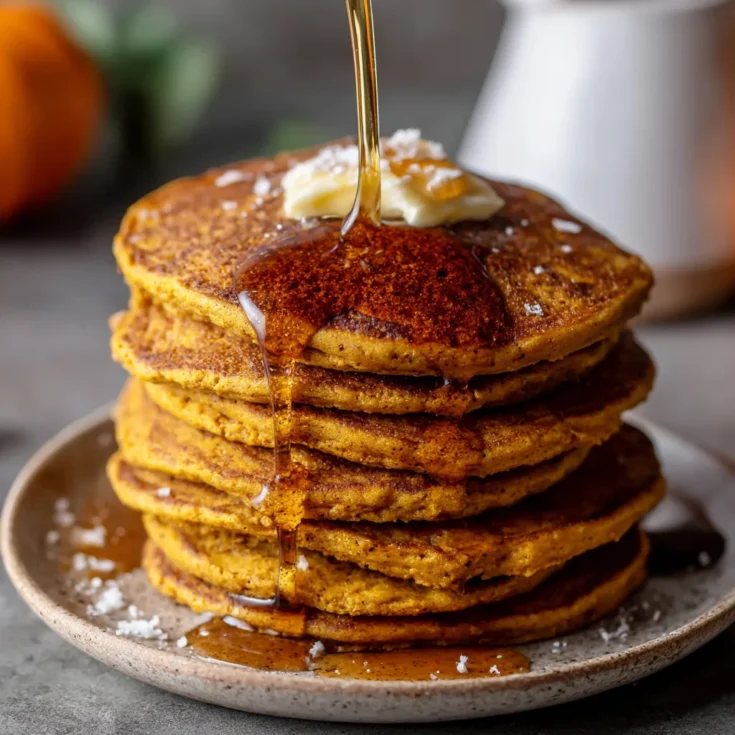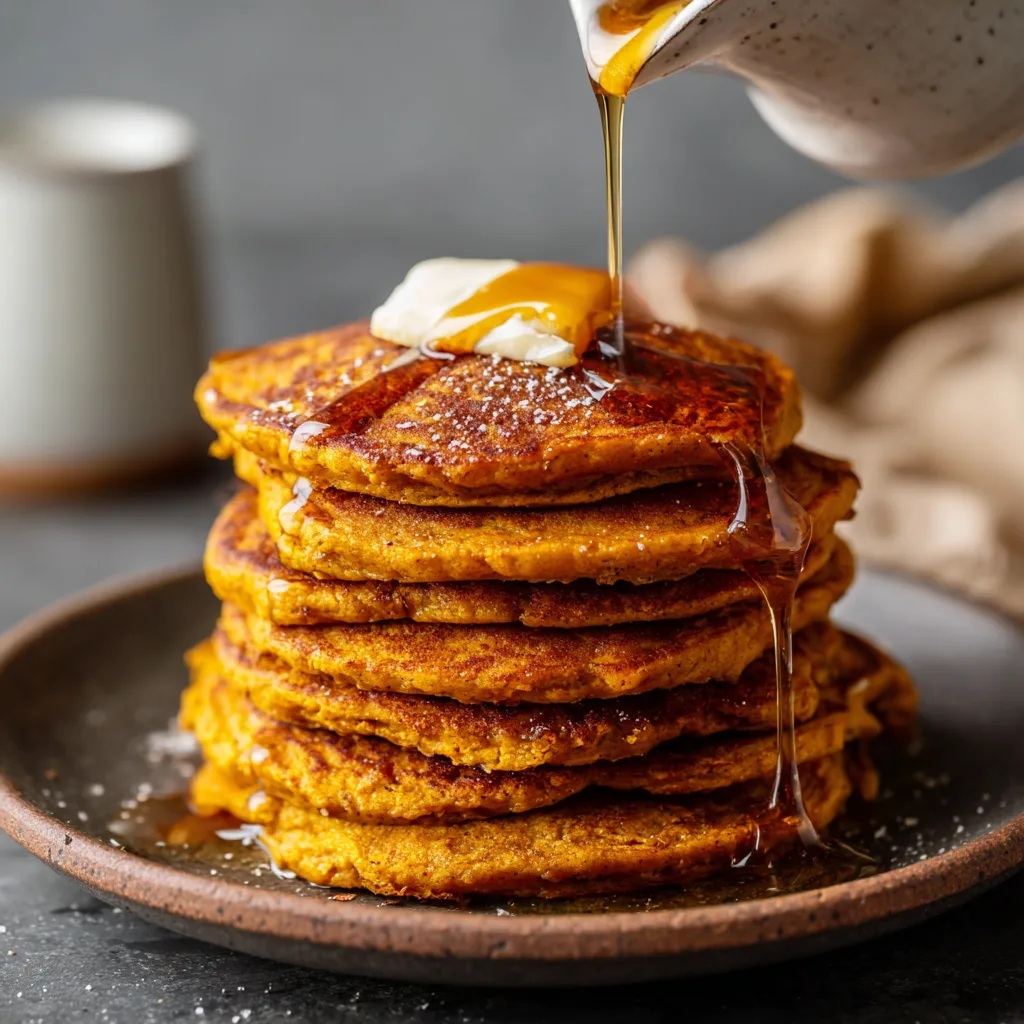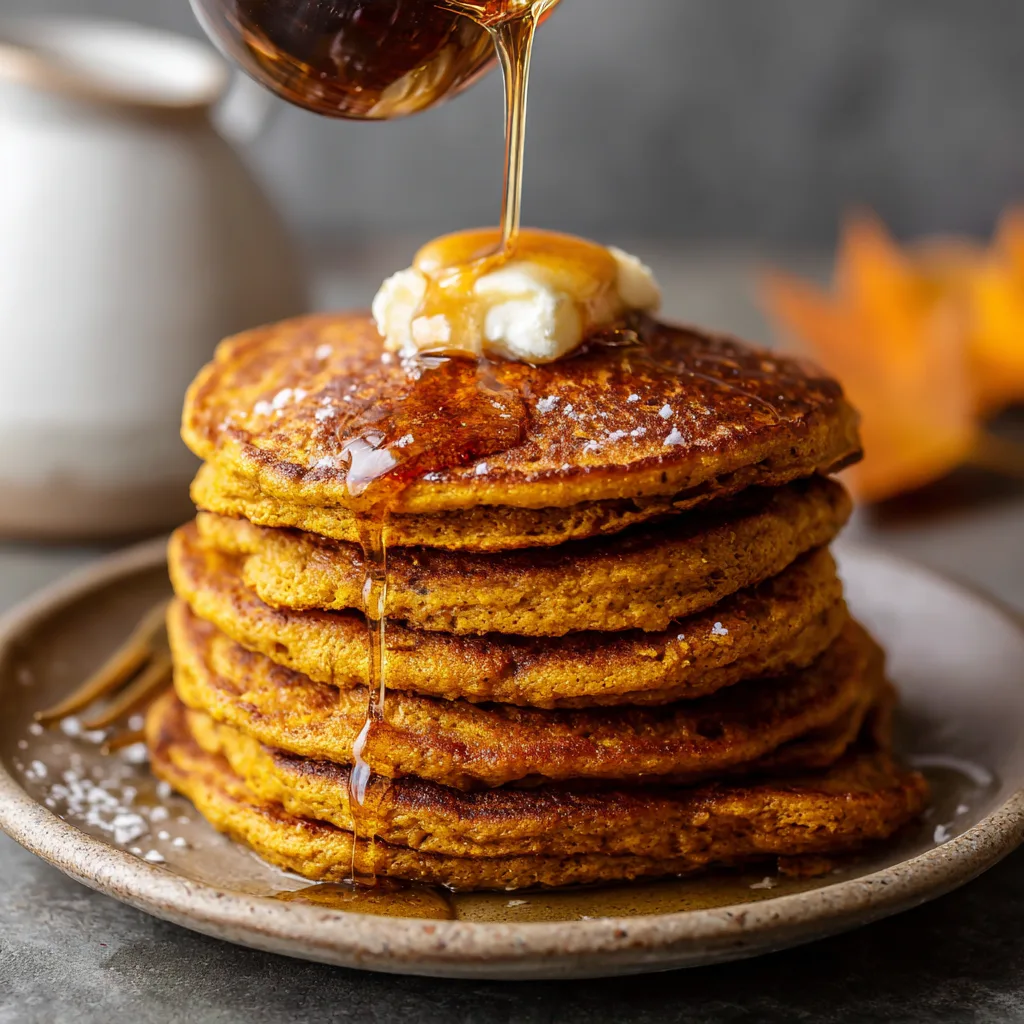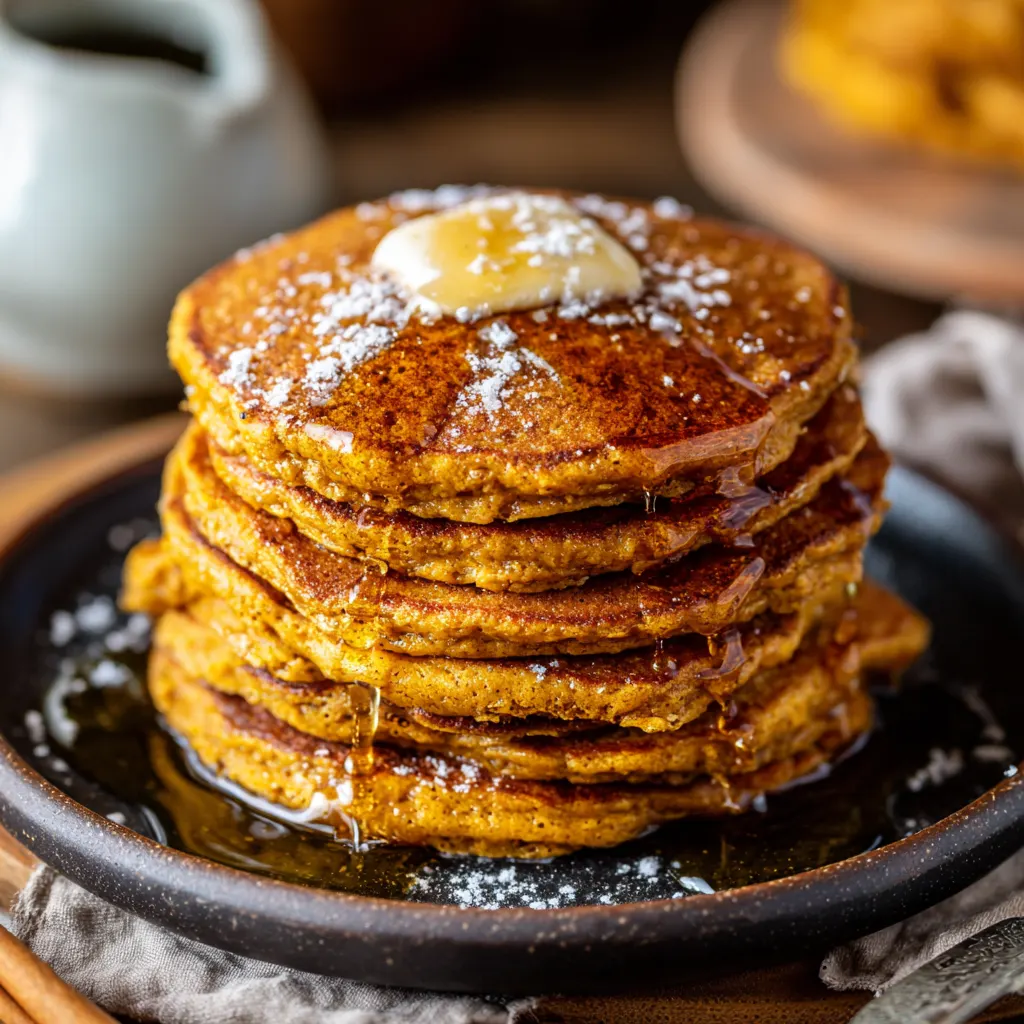When autumn arrives, the warm, comforting flavors of pumpkin pancakes take center stage. These fluffy, spiced pancakes capture the essence of fall with every bite. The inviting aroma of cinnamon and nutmeg combined with rich pumpkin puree makes them a seasonal favorite. Whether enjoyed for breakfast or brunch, pumpkin pancakes bring warmth and joy to chilly mornings.
Choosing vegan pumpkin pancakes adds another layer of goodness. These recipes use plant-based ingredients that exclude eggs, dairy, and other animal products, making them suitable for vegans and those with dietary restrictions. Vegan pumpkin pancakes have gained popularity due to their health benefits, environmental friendliness, and cruelty-free nature. More people are embracing plant-based diets, and vegan pumpkin pancakes offer a tasty, inclusive option.
What makes this recipe truly simple is its reliance on common pantry staples and straightforward preparation. No complicated techniques or hard-to-find ingredients are necessary. This approach ensures even beginner cooks can whip up a batch of fluffy, flavorful pancakes quickly. Plus, the recipe adapts easily to different preferences and dietary needs.
In this article, you will discover why pumpkin pancakes suit the fall season perfectly. You’ll learn the nutritional benefits pumpkin provides and how vegan pancakes differ from traditional versions. Step-by-step guidance will help you master the recipe with ease. Finally, we’ll explore helpful tips, ingredient swaps, and serving ideas to make these pancakes your new seasonal favorite.
Why Pumpkin Pancakes Are Perfect for Fall: Seasonal Flavor and Nutritional Boost
Pumpkin naturally shines in autumn, with its rich, earthy flavor and smooth texture. It pairs wonderfully with spices like cinnamon, nutmeg, ginger, and cloves, creating the quintessential fall taste. Pumpkin’s availability during the cooler months makes it a convenient and festive ingredient to incorporate into breakfasts.
Beyond flavor, pumpkin packs a nutritional punch. It is rich in vitamins A and C, which support immune health. The fiber in pumpkin aids digestion and promotes fullness, making pancakes more satisfying. Additionally, pumpkin contains antioxidants that combat inflammation and support overall wellness. These benefits add a healthy twist to a beloved comfort food.
Pumpkin pancakes also serve as a versatile comfort dish. They can be dressed up with sweet syrups, fresh fruit, or crunchy nuts, or enjoyed simply on their own. Their hearty yet tender texture satisfies cravings for something warm and nourishing during crisp fall mornings.
What Makes Pancakes Vegan? Key Plant-Based Ingredients and Benefits
Traditional pancakes rely on eggs, dairy milk, and butter. Vegan pancakes swap these for plant-based alternatives that mimic texture and flavor without animal products. Common egg substitutes include flaxseed meal mixed with water, chia seeds, or applesauce. These bind ingredients and add moisture.
Instead of cow’s milk, vegan recipes use almond, oat, soy, or coconut milk. These plant milks keep the batter smooth and tender. For fat, vegan butter, coconut oil, or neutral vegetable oils replace dairy butter. These choices maintain richness and help pancakes cook evenly.
Vegan pumpkin pancakes offer multiple benefits. They suit those with dairy or egg allergies and anyone following a vegan lifestyle. Plant-based pancakes tend to have fewer saturated fats and cholesterol, supporting heart health. Environmentally, vegan ingredients require fewer resources, reducing carbon footprint. By choosing vegan, you enjoy delicious pumpkin pancakes that nourish your body and respect the planet.
Key Ingredients for Simple Vegan Pumpkin Pancakes: Essentials for Flavor and Texture
Pumpkin puree forms the heart of these pancakes, delivering moistness and vibrant color. You can choose fresh pumpkin puree made by cooking and mashing pumpkin flesh, or opt for canned pumpkin puree, which offers convenience without sacrificing flavor. Both work well, but canned pumpkin provides consistent texture and saves time.
The flour you select influences the pancake’s texture and nutritional profile. All-purpose flour creates soft, tender pancakes, while whole wheat flour adds nuttiness and extra fiber. For gluten-free diets, options like oat flour, buckwheat flour, or a gluten-free flour blend keep pancakes light and fluffy.
Plant-based milk is key to a smooth batter. Popular choices include almond milk, known for its mild flavor; oat milk, which adds creaminess; soy milk, rich in protein; and coconut milk, offering subtle tropical notes. Each milk alternative lends a unique twist, allowing customization.
Natural sweeteners enhance pumpkin’s earthy sweetness. Maple syrup brings classic flavor and moisture. Coconut sugar provides a caramel-like taste with a lower glycemic index. You can also use agave nectar or date syrup as alternatives, tailoring sweetness to preference.
To replace eggs, vegan pumpkin pancakes commonly use flaxseed meal or chia seeds mixed with water. These create a gel-like binding agent that holds the batter together. Unsweetened applesauce offers moisture and slight sweetness, making it a versatile egg substitute.
Leavening agents like baking powder and baking soda are essential for fluffiness. They help the pancakes rise and develop a light texture. Proper measurement is critical; too much or too little affects the rise and taste.
Spices transform simple pumpkin pancakes into a warm, fragrant treat. Cinnamon adds sweetness and depth. Nutmeg offers a hint of earthiness. Ginger provides mild heat, while cloves contribute a rich, aromatic bite. Together, they create the classic pumpkin spice profile.
Optional add-ins let you personalize your pancakes. Vanilla extract boosts overall flavor. Chopped nuts add crunch and richness. Vegan chocolate chips offer a sweet surprise. You can also mix in shredded coconut or dried fruit for texture and variety.
Ingredient Substitutions and Variations: Tailoring Vegan Pumpkin Pancakes to Your Needs
For gluten-free pancakes, replace regular flour with gluten-free blends, oat flour, or almond flour. Ensure your baking powder is gluten-free to avoid hidden gluten. These swaps keep pancakes tender without compromising taste.
If you want to reduce sugar, substitute natural sweeteners with zero-calorie options like stevia or monk fruit. Adjust quantities carefully to maintain sweetness without bitterness.
Nut allergies require careful choices. Instead of almond milk, try oat, rice, or soy milk. Avoid nuts as toppings and select seed-based alternatives like pumpkin or sunflower seeds for crunch.
Customizing spice blends lets you adjust flavor intensity. For a milder taste, reduce cloves and ginger. For a bolder spice punch, increase cinnamon or add cardamom. Experimentation helps you find your perfect fall flavor.
Pantry Staples to Keep on Hand for Vegan Pancakes: Simplifying Your Cooking
Having versatile vegan baking ingredients at home makes pancake prep quick and stress-free. Stock these essentials:
-
All-purpose or whole wheat flour
-
Baking powder and baking soda
-
Flaxseed meal or chia seeds for egg substitutes
-
Canned pumpkin puree
-
Plant-based milks (almond, oat, soy)
-
Natural sweeteners like maple syrup or coconut sugar
-
Ground cinnamon, nutmeg, ginger, and cloves
-
Vanilla extract
-
Coconut oil or vegetable oil
Keeping these staples ready helps you whip up vegan pumpkin pancakes anytime. They also serve as building blocks for other vegan baked goods and breakfast recipes, adding flexibility to your kitchen.
Step-by-Step Guide to Making Simple Vegan Pumpkin Pancakes: Master the Batter and Preparation
Start by gathering all your ingredients to streamline the process. Measure your dry ingredients—flour, spices, baking powder, and baking soda—in one bowl. In a separate bowl, combine wet ingredients such as pumpkin puree, plant-based milk, maple syrup, and your vegan egg substitute. This separation prevents overmixing and helps achieve an even batter.
When combining wet and dry components, pour the wet mixture into the dry bowl gradually. Stir gently with a spatula or whisk until just combined. Avoid overmixing; some lumps are fine and help keep pancakes tender. If your batter feels too thick, add a splash more plant milk. If it’s too runny, sprinkle in a bit more flour to reach a pourable, but not watery, consistency.
For vegan egg substitutes like flaxseed or chia seed “eggs,” mix one tablespoon of ground seeds with three tablespoons of water and let sit for five minutes until gelatinous. This mix binds ingredients effectively and adds moisture without heaviness. Applesauce can also work as a moisture-rich binder, offering slight sweetness.
Cooking Techniques for Fluffy Vegan Pumpkin Pancakes: Perfect Pan, Heat, and Timing
Choose a non-stick skillet or a well-seasoned cast iron pan to prevent sticking and ensure even browning. Preheat the pan over medium heat; too hot and pancakes burn outside before cooking inside, too cool and they won’t brown properly.
Test the pan’s temperature by flicking a few drops of water onto the surface. If they dance and evaporate quickly, the pan is ready. Lightly grease the pan with coconut oil or vegan butter to enhance browning and prevent sticking.
Pour about ¼ cup of batter per pancake onto the skillet, leaving space between each. Watch for bubbles forming on the surface and edges looking set before flipping—usually after 2 to 3 minutes. Flip gently with a thin spatula, then cook the other side for another 2 minutes or until golden brown.
Cooking time depends on pancake size. Smaller pancakes cook faster and are easier to flip, while larger pancakes may need slightly longer on each side. Adjust heat as needed to prevent burning.
Common Mistakes and How to Avoid Them: Troubleshooting Your Pancakes
If your batter is too thin, pancakes can spread too much and become flat. Thicken by adding a little more flour or reducing plant milk. Conversely, if batter feels too thick and lumpy, add small amounts of plant milk until it reaches a smooth, pourable texture.
Pancakes sticking to the pan often result from insufficient greasing or a pan not fully preheated. Use a non-stick surface and heat the pan properly. Reapply a light coating of oil between batches if needed.
Dense or flat pancakes may be due to expired leavening agents. Always use fresh baking powder and baking soda. Overmixing batter also develops gluten, causing toughness. Mix gently and only until ingredients come together.
To avoid overcooking or burning, keep the heat medium or medium-low. Flip pancakes as soon as bubbles appear and the edges look set. Remove them from the pan when both sides are golden brown.
Serving Suggestions and Toppings: Elevate Your Vegan Pumpkin Pancakes
Serve your pumpkin pancakes warm, topped with vegan butter that melts delightfully into every bite. Drizzle with pure maple syrup for natural sweetness. Fresh fruits like sliced bananas, berries, or apple slices add vibrant flavor and texture.
Add crunch with chopped nuts, such as pecans or walnuts, or sprinkle toasted coconut flakes for tropical flair. Vegan whipped cream brings a creamy touch, while nut butters like almond or cashew provide rich, satisfying flavor.
For a savory twist, try topping pancakes with sautéed mushrooms, vegan cheese, or avocado slices paired with fresh herbs. These options create a unique flavor profile, perfect for those who prefer less sweetness.
With these preparation and serving tips, your simple vegan pumpkin pancakes will impress every time—fluffy, flavorful, and perfectly suited to your taste.
Nutritional Profile of Vegan Pumpkin Pancakes: A Balanced and Nourishing Start
Vegan pumpkin pancakes offer a satisfying blend of calories and nutrients to fuel your morning. A typical serving provides moderate calories, primarily from complex carbohydrates found in flour and natural sugars in pumpkin and sweeteners. Healthy fats come from plant oils or vegan butter, while protein content varies based on flour type and milk choice.
Pumpkin enriches these pancakes with essential vitamins and minerals. It is high in vitamin A, supporting vision and immune function. Vitamin C contributes to skin health and healing, while potassium aids in heart and muscle function. The warming spices—cinnamon, nutmeg, ginger, and cloves—add antioxidants, which protect cells from damage and reduce inflammation.
These pancakes also provide valuable dietary fiber, mainly from pumpkin and whole grain flours. Fiber improves digestion, promotes a feeling of fullness, and helps regulate blood sugar levels. This makes vegan pumpkin pancakes not just tasty but beneficial for digestive health and sustained energy.
Benefits of a Vegan Diet with Pumpkin Pancakes as a Nourishing Breakfast Option
Incorporating vegan pumpkin pancakes into a plant-based diet supports balanced nutrition. They provide energy without animal fats or cholesterol, which may reduce the risk of heart disease. The use of whole-food ingredients aligns with vegan principles emphasizing nutrient density and minimal processing.
Pumpkin and its spices contain antioxidants and anti-inflammatory compounds that support overall health. These substances may help lower oxidative stress and improve immune resilience. Starting the day with such foods sets a positive tone for wellness.
Compared to traditional pancakes made with eggs, dairy, and refined sugar, vegan pumpkin pancakes typically contain less saturated fat and fewer empty calories. They offer a wholesome alternative that doesn’t compromise on taste or satisfaction. For anyone seeking a healthy, flavorful, and compassionate breakfast, these pancakes deliver on all fronts.
Frequently Asked Questions About Simple Vegan Pumpkin Pancakes
Can I use fresh pumpkin instead of canned?
Yes, fresh pumpkin works well. Roast or steam pumpkin until soft, then puree it. Keep in mind fresh pumpkin has more water, so you may need to reduce the plant milk slightly to maintain batter consistency.
How do I store leftover vegan pumpkin pancakes?
Store leftovers in an airtight container in the refrigerator for up to three days. To keep them moist, place a paper towel inside the container to absorb excess moisture.
Can I freeze these pancakes?
Absolutely. Let pancakes cool completely, then layer them between parchment paper in a freezer-safe bag. Freeze for up to two months. Reheat in a toaster or oven for best texture.
What vegan egg substitute works best?
Flaxseed or chia seed “eggs” are most popular. Mix 1 tablespoon ground seeds with 3 tablespoons water, let sit five minutes. Applesauce is also a great binder and adds moisture.
Are pumpkin pancakes gluten-free?
Only if you use gluten-free flour and baking powder. Otherwise, standard flours contain gluten. Be sure to check ingredient labels.
How to make pancakes fluffier without eggs?
Use fresh baking powder and soda for proper rise. Gently mix batter and avoid overmixing. Adding a splash of sparkling water can add extra lightness.
Can I make this recipe oil-free?
Yes. Replace oil with mashed banana or applesauce to maintain moisture, though texture may vary slightly.
How to adjust sweetness if I don’t want it too sweet?
Reduce the amount of maple syrup or sugar in the batter. You can also skip sweet toppings and opt for fresh fruit instead.
Simple Vegan Pumpkin Pancakes – Fluffy, Cozy & Plant-Based

A quick and easy recipe for fluffy, flavorful pumpkin pancakes perfect for a cozy vegan breakfast or brunch. Made with simple pantry staples and warming fall spices.
Ingredients
- 1 cup canned pumpkin puree
- 1 cup plant-based milk (almond, oat, soy)
- 1 tbsp flaxseed meal + 3 tbsp water (vegan egg substitute)
- 1 cup all-purpose or gluten-free flour
- 1 tbsp maple syrup or preferred sweetener
- 1 tsp baking powder
- ½ tsp baking soda
- 1 tsp ground cinnamon
- ½ tsp ground nutmeg
- ¼ tsp ground ginger
- Pinch of cloves
- 2 tbsp coconut oil or vegetable oil (for cooking)
Instructions
Notes
Troubleshooting Common Issues
Pancakes are too dry or crumbly
This often means too much flour or not enough liquid. Add a little more plant-based milk or reduce flour slightly next time.
Pancakes don’t hold together well
Make sure your vegan egg substitute is well-prepared and fully gelatinous. Also, avoid overmixing, which weakens the batter’s structure.
Batter too runny or too thick
Adjust consistency by adding plant milk if too thick, or flour if too runny. The batter should pour easily but hold shape on the pan.
With these tips and answers, you’ll be confident crafting perfect vegan pumpkin pancakes every time




